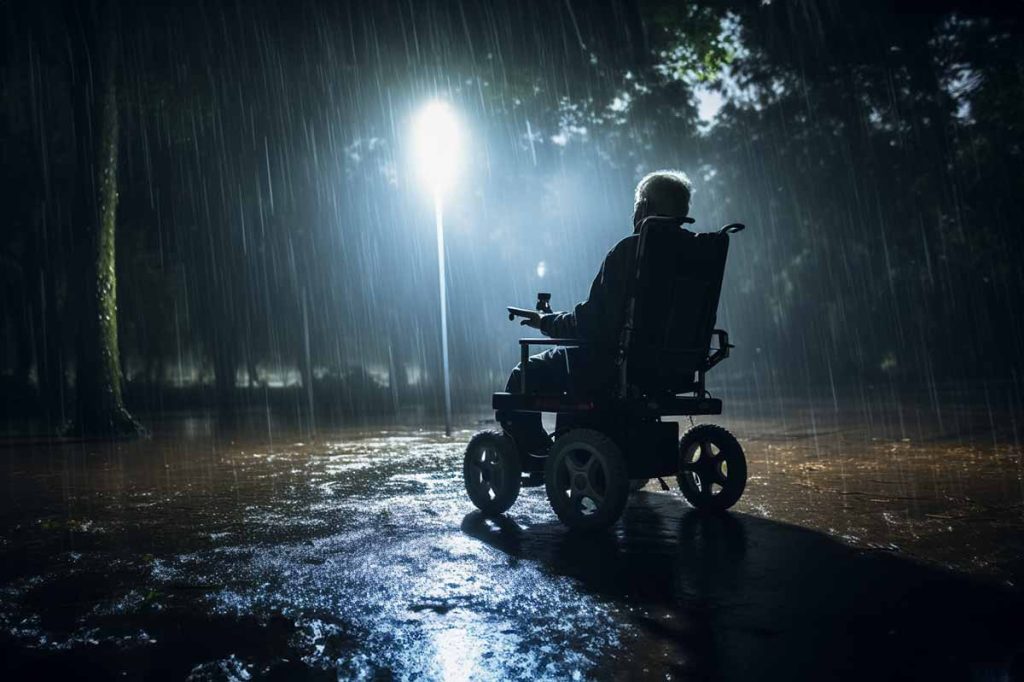Can Electric Wheelchairs Get Wet? Exploring Moisture Risks
If you’re concerned about what could happen if your electric wheelchair gets wet, you’re not alone. Water can potentially harm both the electrical components and the frame of your wheelchair.
In this blog post, we’ll offer guidance on how to handle such a situation and share practical tips to help safeguard your mobility device from exposure to water. Let’s get started!
Key takeaways
- Electric wheelchairs are prone to water damage, jeopardizing electrical components and the frame.
- Extended exposure to moisture can lead to corrosion and rust, impacting the wheelchair’s functionality.
- Act swiftly if your wheelchair gets wet. Disconnect power, thoroughly dry the chair, especially connectors, and consider air-drying for hard-to-reach areas.
- Invest in waterproof accessories like covers, moisture-resistant materials, water-repellent gloves, and storage bags.
Can Electric Wheelchairs Get Wet?
That’s a resounding, but unfortunate, yes. Electric wheelchairs are vulnerable to damage when exposed to water.
Moisture can harm the electrical components and lead to corrosion and rust, posing a significant risk to the wheelchair’s functionality.

The primary concern is the corrosion of electrical components, which can occur when moisture seeps into critical areas. Even a well-constructed electric wheelchair can suffer if it’s left in wet conditions for extended periods.
If water infiltrates the wiring system or battery compartment, it can cause severe issues, ultimately affecting your mobility and independence.
What to Do If Your Electric Wheelchair Gets Wet
Firstly, if the unforeseen happens and your electric wheelchair gets wet, acting quickly is essential.
- Disconnect Power Sources: This precautionary measure helps prevent further damage to the electrical components of your wheelchair.
- Thoroughly Dry the Chair: After disconnecting the power, use a clean towel to thoroughly dry each part of the wheelchair. Pay special attention to connectors, joysticks, controllers, or any areas where water could potentially seep in.
- Air-Drying: For those hard-to-reach or hidden areas, consider using air-drying to ensure that every part of the chair is dry.
- Assess After Heavy Rainfall: If your wheelchair has been exposed to heavy rainfall, it’s a good practice to assess it before using it again. Having the chair checked by professional repair services ensures safe usage.
Tips for Protecting Your Electric Wheelchair from Water
Investing in waterproof wheelchair accessories is a smart way to shield your electric wheelchair from water damage.
Here are some examples of how these accessories can help:
Waterproof Wheelchair Cover: A waterproof wheelchair cover can be a lifesaver during unexpected wet weather incidents. It not only keeps you dry but also helps protect the entire chair from moisture.
Moisture-Resistant Material: Ensuring that your wheelchair’s material is moisture- and water-resistant provides an additional protective barrier. This can help prevent water from seeping into the chair’s structure.
Water-Repellent Wheelchair Gloves: Water-repellent wheelchair gloves do more than just protect your hands. They also prevent potentially risky drips onto electrical parts when you’re maneuvering the device.
Waterproof Storage Bag: Using a waterproof bag for storage compartments is another great practice. This ensures that your belongings stay dry even in wet conditions.
The Bottom Line
Electric wheelchairs should ideally be kept away from water, as it can indeed harm the electrical components and frame.
Taking preventive measures such as sheltering the wheelchair during rainy or snowy weather, using a rain cover, and ensuring it’s thoroughly dried after exposure to moisture can go a long way in safeguarding it from potential issues.
